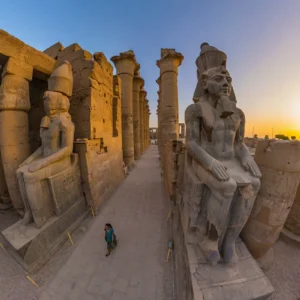King Amenhotep IV (Akhenaten) :
King Amenhotep IV, known as (Akhenaten), which means the living spirit of Aten, is an Egyptian pharaoh from the Eighteenth Dynasty. His father was King Amenhotep III and his mother was Queen Tiye.
King Amenhotep IV is considered the youngest son. He had an older brother called “Thutmose,” who was the one who would assume the throne after his father’s death, but he died before assuming the throne, and King “Amenhotep IV” (Akhenaten) became the one who assumed the throne. King Amenhotep IV married Queen Nefertiti, who was his royal wife. King Amenhotep IV also married a second wife called Kia. The second wife was important as the mother of King Tutankhamun.
King Amenhotep IV received his education at the hands of the scribes “Hikuroshu” or “Miri-Ra II” or the royal teacher “Amenhotep-Hui” or the minister “April”. The Egyptologist “Cyril Aldred” indicated that Prince “Amenhotep IV” (Akhenaten) may have He was the high priest of “Ptah” in Memphis, although there is no evidence for this. Thutmose, the eldest brother of King Amenhotep IV before his death, was the one who occupied all the roles. Egyptologists know little about the life of King Amenhotep IV when he was and still is a prince. It has been suggested that Dunand B. Reed Ford stated that King Amenhotep IV (Akhenaten) was born before the twenty-fifth year of the reign of his father, King Amenhotep III.
The reign of King Amenhotep IV:
King Amenhotep IV had ascended the throne after the death of his father, King Amenhotep III. Some believed that there was a shared rule between King Amenhotep IV and his father, King Amenhotep III, on the throne before his death. Some object to the validity of this statement. Archaeologists have found the names of King Amenhotep IV and Amenhotep III is engraved on the wall of the tomb of Minister Amenhotep-Hui in Luxor.
The Egyptian Ministry of Antiquities described this as conclusive evidence that King Amenhotep IV shared power with his father, King Amenhotep III, for at least eight years, based on the history of the tomb, but some Others, such as Egyptologists, believe that the inscription only indicates the date of construction of the tomb and that Amenhotep-Hui began during the reign of Amenhotep III and ended during the reign of King Amenhotep IV, as King Amenhotep IV tried to unify the gods in ancient Egypt, where there were multiple gods. He also made the god in the form of one god, which is “Aton,” and moved the capital from Thebes to a new capital, “Akhtaten” in Minya, where realistic art appeared, not only in sculpture and painting, as in the tomb of “Ra Musi”, and a new literature emerged characterized by hymns to the new god, “Aten”, now known as Tell el-Amarna.
King Amenhotep IV (Akhenaten) was also busy with his philosophy. And his religious reforms, he turned away from foreign policy and the administration of the empire extending to the upper Euphrates and Nubia in the south.
Acts of King Amenhotep IV (Akhenaten):
King Amenhotep IV (Akhenaten) built a temple to the god “Aten” in Karnak, the sacred place of the god “Amun Ra,” thus threatening the eternal, stable state of Amun Ra and his priests, challenging their father in their backyard, which made them harbor hatred and plot against him, and after that he left their city Thebes. The capital, and King Amenhotep IV used the plastic arts to spread his teachings. He worked himself to teach and guide the artists of his time because he considered it necessary to translate his new religious ideas into realistic forms. In the temple that he built east of Karnak Laton, the image of the king and the images of his family were treated with amazing realism.
Death of King Amenhotep IV (Akhenaten):
King Amenhotep IV (Akhenaten) died after seventeen years in rule and was initially buried in the Royal Valley cemetery east of Akhenaten, where he ordered the construction of the cemetery and the pharaoh was buried there. Then he was revived on one of the border paintings.
King Akhenaten was reburied in Tomb No. KV55, and the mummy found in this tomb was identified as Amenhotep IV (Akhenaten). The mummy was examined repeatedly using DNA analysis, and the results were published in 2010.
The results were that King Amenhotep IV (Akhenaten) was the father of King Tutankhamun, and the validity of these results was questioned.
Egypt Tours to The Monuments Built by King Amenhotep IV, Akhenaten
-
From $1440 🎗 10% OFFAswan, Cairo, Egypt, Luxor

 Sale! Add to cart
7 Days Deluxe Nile cruise + Domestic Flights
Sale! Add to cart
7 Days Deluxe Nile cruise + Domestic Flights7 Days Tour To Egypt with Cairo, Aswan, Luxor, and Nile Cruise
Rated 5.00 out of 5Cairo and Luxor Tour Packages7-Days Tour To Egypt with Cairo, Aswan, Luxor, and Nile Cruise Egypt Cruis Era provides you with a 7 days tour to Egypt that covers the essentials of Cairo, Aswan, Luxo -
From $690 🎗 0% OFFAlexandria, Cairo, Luxor

 Sale! Add to cart
6 Days Deluxe Nile cruise + Domestic FlightsWhat to bring with you? A trip to Egypt takes you to a mystical destination where you can di
Sale! Add to cart
6 Days Deluxe Nile cruise + Domestic FlightsWhat to bring with you? A trip to Egypt takes you to a mystical destination where you can di -
From $1134 🎗 10% OFFCairo, Egypt, Luxor

 Sale! Add to cart
6 Days Air-conditioned van + Sleeping Train
Sale! Add to cart
6 Days Air-conditioned van + Sleeping Train6 Days Egypt Tour Package To Cairo and Luxor with Train
Rated 5.00 out of 5Cairo and Luxor Tour Packages6 Days Egypt Tour Package To Cairo and Luxor with Train Our 6 Days Egypt Tour Package To Cairo and Luxor with Train is your opportunity to Enjoy the best Egypt tours whil -
From $1243 🎗 0% OFFAlexandria, Cairo, Luxor

 Sale! Add to cart
6 Days Deluxe Nile cruise + Domestic FlightsWhy you’ll love this trip: Enjoy this amazing package, give yourself a chance to visit north and south of Egypt Travel back in time to h
Sale! Add to cart
6 Days Deluxe Nile cruise + Domestic FlightsWhy you’ll love this trip: Enjoy this amazing package, give yourself a chance to visit north and south of Egypt Travel back in time to h -
Why you’ll love this trip: Tick off the historic highlights of Luxor’s fabled West Bank and lively East Bank, and visit the UNESCO-listed Valley of t
-
From $1764 🎗 10% OFFAbu Simbel, Aswan, Cairo, Egypt, Luxor

 Sale! Add to cart
8 Days Deluxe Nile cruise + Domestic Flights
Sale! Add to cart
8 Days Deluxe Nile cruise + Domestic Flights8 Days Egypt Tour with Pyramids, Nile Cruise and Abu Simbel
Rated 5.00 out of 5Cairo and Abu Simbel Tour packages8 Days Egypt Tour with Pyramids, Nile Cruise and Abu Simbel Egypt’s fascinating history will immerse you in 5000 years of narrative in just 8 days, beginning with t






